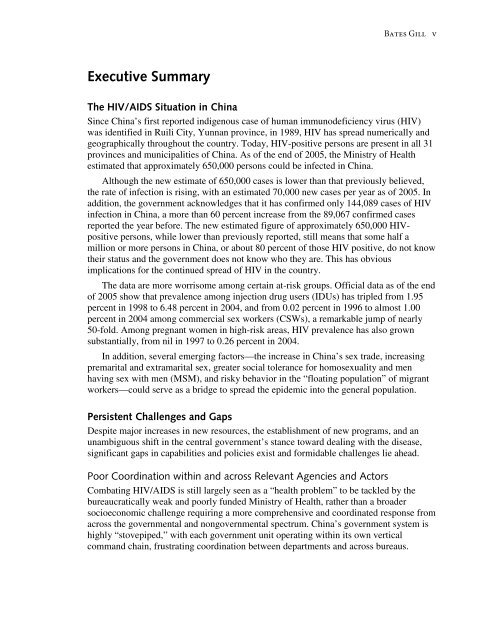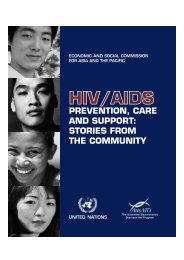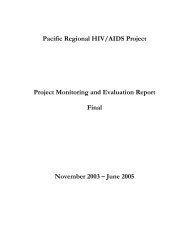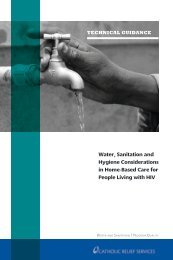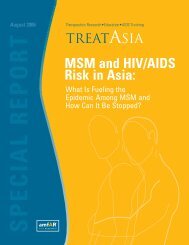Assessing HIV/AIDS Initiatives in China - Center for Strategic and ...
Assessing HIV/AIDS Initiatives in China - Center for Strategic and ...
Assessing HIV/AIDS Initiatives in China - Center for Strategic and ...
Create successful ePaper yourself
Turn your PDF publications into a flip-book with our unique Google optimized e-Paper software.
Bates Gill v<br />
Executive Summary<br />
The <strong>HIV</strong>/<strong>AIDS</strong> Situation <strong>in</strong> Ch<strong>in</strong>a<br />
S<strong>in</strong>ce Ch<strong>in</strong>a’s first reported <strong>in</strong>digenous case of human immunodeficiency virus (<strong>HIV</strong>)<br />
was identified <strong>in</strong> Ruili City, Yunnan prov<strong>in</strong>ce, <strong>in</strong> 1989, <strong>HIV</strong> has spread numerically <strong>and</strong><br />
geographically throughout the country. Today, <strong>HIV</strong>-positive persons are present <strong>in</strong> all 31<br />
prov<strong>in</strong>ces <strong>and</strong> municipalities of Ch<strong>in</strong>a. As of the end of 2005, the M<strong>in</strong>istry of Health<br />
estimated that approximately 650,000 persons could be <strong>in</strong>fected <strong>in</strong> Ch<strong>in</strong>a.<br />
Although the new estimate of 650,000 cases is lower than that previously believed,<br />
the rate of <strong>in</strong>fection is ris<strong>in</strong>g, with an estimated 70,000 new cases per year as of 2005. In<br />
addition, the government acknowledges that it has confirmed only 144,089 cases of <strong>HIV</strong><br />
<strong>in</strong>fection <strong>in</strong> Ch<strong>in</strong>a, a more than 60 percent <strong>in</strong>crease from the 89,067 confirmed cases<br />
reported the year be<strong>for</strong>e. The new estimated figure of approximately 650,000 <strong>HIV</strong>positive<br />
persons, while lower than previously reported, still means that some half a<br />
million or more persons <strong>in</strong> Ch<strong>in</strong>a, or about 80 percent of those <strong>HIV</strong> positive, do not know<br />
their status <strong>and</strong> the government does not know who they are. This has obvious<br />
implications <strong>for</strong> the cont<strong>in</strong>ued spread of <strong>HIV</strong> <strong>in</strong> the country.<br />
The data are more worrisome among certa<strong>in</strong> at-risk groups. Official data as of the end<br />
of 2005 show that prevalence among <strong>in</strong>jection drug users (IDUs) has tripled from 1.95<br />
percent <strong>in</strong> 1998 to 6.48 percent <strong>in</strong> 2004, <strong>and</strong> from 0.02 percent <strong>in</strong> 1996 to almost 1.00<br />
percent <strong>in</strong> 2004 among commercial sex workers (CSWs), a remarkable jump of nearly<br />
50-fold. Among pregnant women <strong>in</strong> high-risk areas, <strong>HIV</strong> prevalence has also grown<br />
substantially, from nil <strong>in</strong> 1997 to 0.26 percent <strong>in</strong> 2004.<br />
In addition, several emerg<strong>in</strong>g factors—the <strong>in</strong>crease <strong>in</strong> Ch<strong>in</strong>a’s sex trade, <strong>in</strong>creas<strong>in</strong>g<br />
premarital <strong>and</strong> extramarital sex, greater social tolerance <strong>for</strong> homosexuality <strong>and</strong> men<br />
hav<strong>in</strong>g sex with men (MSM), <strong>and</strong> risky behavior <strong>in</strong> the “float<strong>in</strong>g population” of migrant<br />
workers—could serve as a bridge to spread the epidemic <strong>in</strong>to the general population.<br />
Persistent Challenges <strong>and</strong> Gaps<br />
Despite major <strong>in</strong>creases <strong>in</strong> new resources, the establishment of new programs, <strong>and</strong> an<br />
unambiguous shift <strong>in</strong> the central government’s stance toward deal<strong>in</strong>g with the disease,<br />
significant gaps <strong>in</strong> capabilities <strong>and</strong> policies exist <strong>and</strong> <strong>for</strong>midable challenges lie ahead.<br />
Poor Coord<strong>in</strong>ation with<strong>in</strong> <strong>and</strong> across Relevant Agencies <strong>and</strong> Actors<br />
Combat<strong>in</strong>g <strong>HIV</strong>/<strong>AIDS</strong> is still largely seen as a “health problem” to be tackled by the<br />
bureaucratically weak <strong>and</strong> poorly funded M<strong>in</strong>istry of Health, rather than a broader<br />
socioeconomic challenge requir<strong>in</strong>g a more comprehensive <strong>and</strong> coord<strong>in</strong>ated response from<br />
across the governmental <strong>and</strong> nongovernmental spectrum. Ch<strong>in</strong>a’s government system is<br />
highly “stovepiped,” with each government unit operat<strong>in</strong>g with<strong>in</strong> its own vertical<br />
comm<strong>and</strong> cha<strong>in</strong>, frustrat<strong>in</strong>g coord<strong>in</strong>ation between departments <strong>and</strong> across bureaus.


